By Bill Larson and Spc. Justin A. Moeller, 4th Brigade Combat Team Public Affairs
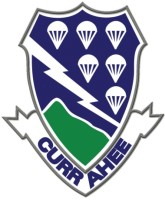 Fort Campbell, KY – The 4th Brigade Combat Team on Thursday held a color casing ceremony marking the transition of the unit to a wartime footing as they prepare to once again deploy to Afghanistan. In November 2012, the Currahees received the news that they would be deploying to Regional Command East (RC-East) this spring, where they will continue to provide training and mentoring to Afghan security forces.
Fort Campbell, KY – The 4th Brigade Combat Team on Thursday held a color casing ceremony marking the transition of the unit to a wartime footing as they prepare to once again deploy to Afghanistan. In November 2012, the Currahees received the news that they would be deploying to Regional Command East (RC-East) this spring, where they will continue to provide training and mentoring to Afghan security forces.
The Brigade and Regimental colors were cased during the ceremony on Thursday and will remain furled until the unit’s command completes its transition to Afghanistan where the colors will be unfurled to fly in combat.
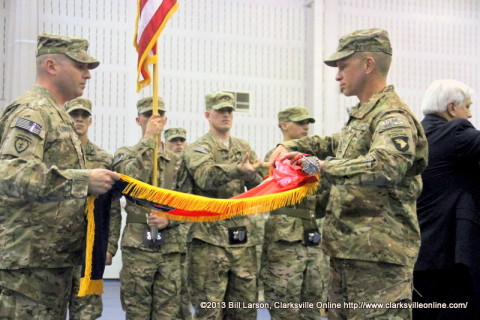
“Flags have traditionally represented units going back in history,” said [retired] Col. Bob Sietz, honorary colonel of the 506th Infantry Regiment. “The casing of the colors is a relatively new ceremony that represents the colors being moved from the headquarters to the place the Soldiers are going.”
The colors, with attached battle streamers, accompany the unit and are displayed to signify that unit’s historic lineage in past campaigns.
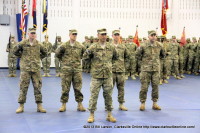
The colors are adorned with streamers representing four presidential unit citations, a valorous unit award, four meritorious unit commendations and 19 campaigns including the French Croix de Guerre with palm for Normandy, the orange lanyard of the Netherlands, the Belgian Croix de Guerre with palm for Bastogne, two Republic of Vietnam Crosses of Gallantry with palms, and the Republic of Vietnam Civic Action Streamer.
The casing of the colors may be a relatively new Army tradition but it symbolizes the moving of the unit to a different theater of operation and serves as a vivid reminder of what the Currahees represent.
“Our history, colors and streamers mean a great deal to the Currahee brigade combat team and the 506th Infantry Regiment,” said Col. Val C. Keaveny, Jr., commander of the 4th BCT, 101st Abn. Div. “They remind us of the incredible sacrifices this brigade and this regiment have made and of the 1,429 fallen Currahees during WWII, Vietnam and since 9/11.”
“We join together to collectively tell the world that the Currahees are ready, we are deploying to answer our nation’s call. We bring with us the strength of the Currahee nation – tens-of-thousands strong, with the support of our Families, Veterans and friends.”
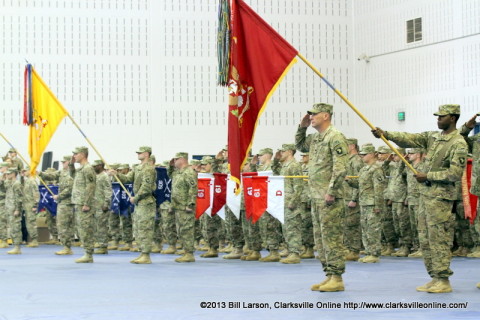
During the ceremony, Currahee Veterans from WWII, Vietnam and recent campaigns presented battle flags to the brigade commander, and battalion, squadron, battery, company and troop commanders. These flags will be flown here as a show of support from the Veterans in the absence of the unit’s colors.
“We’re here because we have great respect for the Soldiers who are stepping up for this deployment,” said Seitz. “We, veterans, think the world of the Currahee Soldiers of today. By giving flags to the brigade, battalions, batteries, companies and troops, we are showing our support.”
“We will fly these battle flags with pride and we will honor the legacy you have passed to us,” Keaveny shared as he accepted and thanked the Veterans for their continued support.
“Our colors have already flown in France, Holland, Germany, Vietnam, Korea, Iraq and Afghanistan,” said Keaveny. “On April 11th, 2013, we prepare our colors, once again, to fly into combat.”
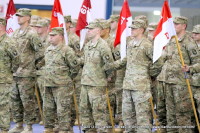
“In the days and weeks ahead, we will add more to the lineage as we unfurl our colors in combat and as we don our 101st Combat Patches. Like the Currahees who have come before us, we have been called upon to serve at a decisive point in our nation’s history.”
This tradition displays the pride and respect that the Currahees have for their prestigious history while representing the unit’s start to a deployment.
“I feel proud to deploy with this great regiment,” said Command Sgt. Maj. Michael A. Grinston, command sergeant major of 4th BCT, 101st Abn. Div. “It will forge a bond for me with those that have deployed in the past with the Currahees and with those that will deploy in the future.”
Currahees have endured rigorous training and exercises in an effort to be a trained, disciplined and fit fighting force in preparation for their next rendezvous with destiny and to continue to bolster the Currahee legacy.
“From the tracer filled skies of D-Day, the bone-chilling cold of Bastogne, the sweltering jungles of Vietnam, the tense moments on the Korean Demilitarized Zone, the blistering heat of Iraq, to the lung-wrenching mountains of Afghanistan, Currahees have proven their mettle, time and time again,” highlighted Keaveny. “I know we will honor that legacy, we will accomplish our mission and we will return with honor.”
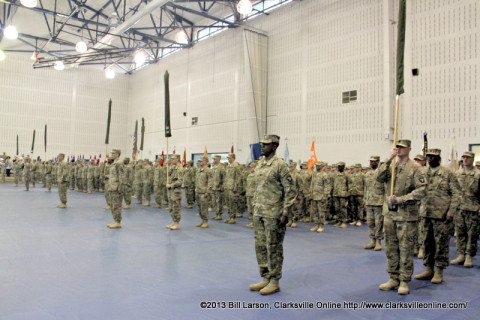
About Colonel Valery C. Keaveny, Jr.
Commander of the 4th Brigade Combat Team
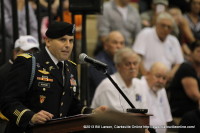
Colonel Valery C. Keaveny, Jr. was commissioned as an infantry officer upon graduation from Florida Tech in 1989. He holds a Bachelors of Science in Aviation Management/Flight Technology from Florida Tech, a Masters of Military Arts and Sciences from the United States Army Command and General Staff College, and a Masters in Strategic Studies from the United States Army War College.
His previous assignments include Rifle Platoon Leader, Scout Platoon Leader, and HHC Executive Officer in 5th Battalion, 9th Infantry Regiment (Manchu), Aide de Camp to the 6th Infantry Division (Light) Assistant Division Commander (Maneuver), and 2nd Brigade Assistant S3 at Fort Wainwright, Alaska. In the 25th Infantry Division (Light) at Schofield Barracks, Hawaii, he served as the 2nd Brigade S1 and as Company Commander of C Company, 1st Battalion, 21st Infantry (Gimlets).
He then served at Fort Campbell, Kentucky with the 101st Airborne Division (Air Assault) as the Division G3 Air, Assault Command Post OIC, and Commander of the Division’s Long Range Surveillance Detachment. Subsequently, COL Keaveny served as the Senior Long Range Surveillance Unit Observer/Controller at the Joint Readiness Training Center at Fort Polk, Louisiana. COL Keaveny was then assigned to Fort Richardson, Alaska where he served as the US Army Alaska G3 Chief of Operations, S3 and Executive Officer for 1st Battalion, 501st Infantry (Airborne), S3 for the 4th Brigade Combat Team (Airborne) / 25th Infantry Division (Light), and Commander of the 3rd Battalion, 509th Infantry (Airborne).
Following battalion command, COL Keaveny served as the Senior Brigade Command and Control Trainer/Mentor at the Joint Readiness Training Center, Fort Polk, Louisiana. His last assignments were as a student in the United States Army War College Advanced Strategic Arts Program and as the Special Assistant to the Commanding General, 101st Airborne Division (Air Assault).
His combat and operational service includes Operation Uphold Democracy, Operation Enduring Freedom, and Operation Iraqi Freedom.
Colonel Keaveny’s awards and decorations include the Bronze Star Medal (2nd Award), Meritorious Service Medal (6th Award), Army Commendation Medal (4th Award), Army Achievement Medal (4th Award), Valorous Unit Award (2nd Award), and Army Superior Unit Award (2nd Award).
He has earned the Combat Infantryman’s Badge, Expert Infantryman’s Badge, Master Parachutists Badge, Pathfinder Badge, Air Assault Badge, and Ranger Tab.
About Command Sgt. Maj. Michael A. Grinston
Command Sergeant Major of the 4th Brigade Combat Team
Command Sgt. Maj. Michael A. Grinston is from Jasper, Alabama and graduated from Walker High School. After attending Walker High School he attended Walker College for one year prior to joining the Army.Command Sergeant Major Michael Grinston joined the Army on 19 October 1987 as a Firing Battery Cannon Crewmember. He has been assigned to 1-84 FA at Fort Lewis, Washington, 2-320th FA at Fort Campbell, Kentucky, two tours at Ledward Barracks in Schweinfurt, Germany, with 5-41 FA and 1-7th FA, 1-39th FA at Fort Bragg, North Carolina, E/1-22 FA Fort Sill, Oklahoma, D/319th FA, 1-508 IN and 2-503 IN at Caserma Ederle in Vicenza, Italy, 2-15 FAR Fort Drum New York, the Joint Multi-National Readiness Center in Hohenfels, Germany, and the 170th Infantry Brigade Combat Team in Baumholder, Germany.
He has been deployed to Desert Shield, Desert Storm, KFOR 4A (Kosovo), Operation Iraqi Freedom (OIF) II, and OIF 06-08, and Afghanistan.
CSM Grinston has held the positions of cannon crewmember, gunner, section chief, gunnery sergeant, chief of firing battery, Drill Sergeant, Senior Drill Sergeant, First Sergeant, Battalion Command Sergeant Major and Brigade Command Sergeant Major.
CSM Grinston’s awards and decorations include: Legion of Merit, Bronze Star with Valor Device (2nd Award), Bronze Star (2nd Award), Meritorious Service Medal (4th Award), Army Commendation Medal (6th Award), Army Achievement Medals(12th Award), the Ranger Tab, Master Parachutist Badge, Air Assault Badge, Drill Sergeant Badge, and the Combat Action Badge.
He has attended the following schools: Ranger School, Airborne School, Air Assault School, Drill Sergeant School, Rappel Master School, Jumpmaster School, Equal Opportunity Leader Course, and all the required NCOES schools. In addition, he has a Bachelor of Science degree in Business Administration from the University of Maryland University College.
CSM Grinston is married to the former Alexandra Pragel from Salz, Germany, and has two girls, Sophia and Isabella.
About Colonel (Ret) Richard Seitz
Honorary Colonel of the 506th Infantry Regiment
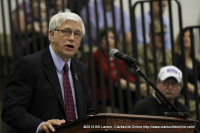
Colonel (retired) Richard Seitz was commissioned a Second Lieutenant, Infantry, in June 1969 from the United States Military Academy at West Point, New York. He retired from active duty in 1993 after 24 years of service.
His military schools include the Infantry Officer Basic Course, US Marine Corps Amphibious Warfare School, Army Command and General Staff College, and National War College. His degrees include a BS in Engineering from West Point, an MA in International Relations from Boston University and a Fellowship in International Affairs from Harvard University.
His combat service was in Vietnam with the 2nd Battalion 506th Infantry, 3rd Brigade, 101st Airborne Division in 1970-1971. During this 18-month period with the 2-506th Infantry, Colonel Seitz served as a Rifle Platoon Leader, a Reconnaissance Platoon Leader, Assistant Battalion S-3 and a Rifle Company Commander.
Other troop assignments included Rifle Company Commander, 1st Battalion, 505th Infantry, later Asst S-3, 3rd Brigade, 82d Airborne Division at Fort Bragg, NC. In Korea, he served as Aide-de-Camp to the Division Commander, later S-3 3rd Brigade, 2nd Infantry Division. In Germany, he served as Inspector General, later Battalion Executive Officer, 3rd Battalion 41st Infantry, later Battalion Commander, 4th Battalion, 41st Infantry, later G-3, 2nd Armored Division (Forward).
His Pentagon assignments included two tours on the Army Staff, one with the Office of Program Analysis and Evaluation and the other as Division Chief, Strategic Plans and Policy. With the Joint Staff, Col Seitz served in J7 as Division Chief, Joint Exercises.
Since his retirement, Colonel Seitz has been with Booz Allen Hamilton, an international consulting firm. He and his family live in Reston, Virginia. Colonel Seitz is a Distinguished Member of the 506th Infantry Regiment. For both the 101st Airborne Division Association and the 506th Infantry Regiment Association, Col Seitz leads the support programs for wounded soldiers and their families recovering at Walter Reed Army Hospital. Colonel Seitz also serves on the Board of Directors for the 506th Airborne Infantry Regiment Association.
About the Currahees
 The Regiment was given the motto “Currahee,” a Native American Cherokee word which means “stands alone”—a name that would become synonymous with its combat history. On March 1st, 1945, the 506th was assigned to the newly formed 101st Airborne Division. The Division’s first commander, Major General William C. Lee observed that “the 101st has no history, but it has a rendezvous with destiny.” The 506th Infantry was destined to write its history in places such as Normandy, Arnhem, Bastogne, the Central Highlands of Vietnam and Cambodia, Iraq, and Afghanistan.
The Regiment was given the motto “Currahee,” a Native American Cherokee word which means “stands alone”—a name that would become synonymous with its combat history. On March 1st, 1945, the 506th was assigned to the newly formed 101st Airborne Division. The Division’s first commander, Major General William C. Lee observed that “the 101st has no history, but it has a rendezvous with destiny.” The 506th Infantry was destined to write its history in places such as Normandy, Arnhem, Bastogne, the Central Highlands of Vietnam and Cambodia, Iraq, and Afghanistan.
Under Colonel Robert F. Sink’s command, the Regiment proved itself over the skies of France as the lead element of the massive Allied D-Day invasion, June 6, 1944. With the objective to seize the high ground immediately behind the Normandy beach in order to prevent the Germans from reinforcing their shoreline defensive positions, the Regiment distinguished itself as the Soldiers of the 506th when they successfully conducted a night airborne insertion into German occupied France and secured their objectives.
For its exploits at Normandy, the 506th Infantry Regiment received a Presidential Unit Citation. The 506th later parachuted into combat as a part of Operation Market Garden and earned its second Presidential Unit Citation for actions while successfully resisting the vicious German assaults at Bastogne. The final significant event during World War II occurred when the 506th drove into Southeastern Germany and overran Hitler’s famed “Eagle Nest” in Berchtesgaden. On Nov. 30, 1945, the 506th Infantry was inactivated at Auxerre, France.
The Regiment was twice reactivated as a training unit at Breckenridge, KY, July 1948 to April 1949 and August 1950 to December 1953, and later reactivated in May 1954 at Fort Jackson, SC. On April 25th, 1957, the 506th was reorganized as part of the 101st Airborne Division at Fort Campbell. In December 1967, the 506th deployed to the Central Highlands of Vietnam. While in Vietnam, the Regiment was converted from Airborne to Airmobile Infantry. They served four years in Vietnam, earned twelve battle streamers and were awarded a fourth Presidential Unit Citation for actions at Dong Ap Bia Mountain at the north of the A Shau Valley.
The 506th was deactivated in 1984. The 1st Battalion, 506th Infantry regiment was later reactivated in 1987, to serve at Camp Greaves in the Korean Demilitarized Zone. They served in Korea until August 2004 when they deployed in support of Operation Iraqi Freedom. From August 2004 to July 2005, the 506th made huge strides in reducing the insurgent menace in their battle space. They conducted numerous search, raid, and sweep missions resulting in the detention of hundreds of insurgents and the destruction of a multitude of weapons and ordinance caches. The 1st Battalion, 506th Infantry Regiment deactivated September 15th, 2005.
The 506th Infantry Regiment was re-activated on Sept. 15, 2005 at Fort Campbell as the 506th Brigade Combat Team, providing regimental designation to the newly created 4th Brigade Combat Team, 101st Airborne Division (Air Assault). The entire Brigade, structured under the Army Modularity Concept, deployed for combat a short two months later to Iraq for a year in support of Operation Iraqi Freedom 05-07.
The Brigade’s Soldiers added to the rich legacy of the 506th, setting the Army standard for route sanitization, conducting thousands of combat missions in Baghdad and Ar Ramadi, capturing or killing over 1,000 insurgents, and training Iraqi Army and Police forces. The Brigade’s task organization included 22 battalion-sized elements. The 1-506th Infantry Battalion fought in Ar Ramadi, while 2-506th Infantry Battalion fought in South Baghdad.
The remainder of the Brigade fought in East Baghdad, securing a population of over 4.9 million residents and a landmass of over 1,600 square kilometers. Soon after a successful redeployment, the Brigade, in the midst of personnel and equipment reset, became the Army’s Division Ready Brigade, once again poised for short-notice worldwide operations.
As the Currahees “Stood Alone” as the Army’s Division Ready Brigade, they deployed to Afghanistan in support of Operation Enduring Freedom in March 2008. The 4th Brigade Combat Team deployed to Afghanistan and transitioned to Combined Task Force Currahee, consisting of almost 6,000 service members from the United States, Poland and the Czech Republic to promote peace and prosperity to the people of Paktya, Paktika, Khost, Ghazni, Logar and Wardak, as part of Combined-Joint Task Force 101. The Currahees returned to Fort Campbell from the operation in March 2009.
In February of 2010, the Brigade received orders to deploy to Afghanistan for the second time.
As part of the final portion of the 2010 surge of Soldiers into Afghanistan as ordered by President Barak Obama, the 4th Brigade Combat Team deployed to Afghanistan in August of 2010 and transitioned into Task Force Currahee as part of Combined-Joint Task Force 101.
The Currahees were deployed to Paktika Province in Eastern Afghanistan in August 2010. Incidentally this was a familiar province to Currahees from their 2008 to 2009 deployment. However this deployment Task Force Currahee moved into only this province, quadrupling the number of Currahees in the area of operation.
Task Force Currahee, partnered with the Afghan National Security Forces and the Government of the Islamic Republic of Afghanistan was responsible for Paktika Province, Eastern Afghanistan in order to promote a stable and peaceful environment free from the tyrannical rule of the Taliban.
After spending nearly a year continuing to build and foster relationships in the province, Currahees completed their redeployment back to Fort Campbell in August of 2011.
They are currently in the process of preparing for another deployment to Afghanistan.


